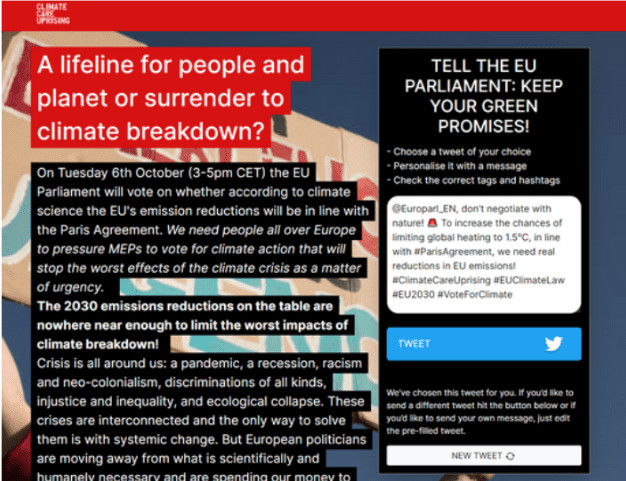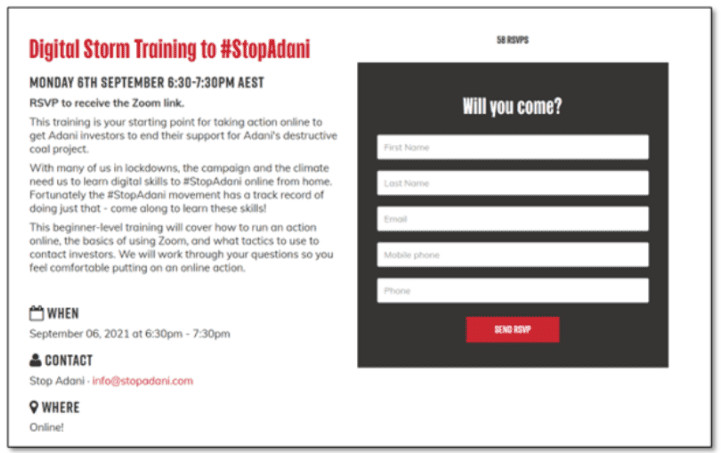Introduction
In today’s interconnected world, the power of online collective action is undeniable. One potent tactic that has emerged and gained prominence, particularly in recent years, is the Digital Storm Online. A digital storm is essentially a coordinated online event where a group of individuals collectively directs messages – through emails, calls, texts, and social media posts – towards a specific corporate or governmental target. This surge of online communication is designed to exert pressure and compel the target to address a particular issue or demand.
The COVID-19 pandemic significantly accelerated the adoption of digital activism methods, and the digital storm online became a particularly popular and effective tool. Across Australia and globally, activists harnessed the power of their keyboards to unleash “digital storms,” driving impactful campaigns from their homes.
The Stop Adani campaign stands as a prime example of the strategic use of digital storms. Activists and local groups effectively organized recurring digital storms targeting financial institutions like the Bank of New York Mellon, HSBC, J P Morgan, BlackRock, Mitsubishi UFG, and the State Bank of India, all linked to investments in Adani’s controversial coal mining projects. The demonstrated success of digital storms in influencing targeted organizations and democratizing activism suggests that this online tactic is not a fleeting trend but a permanent fixture in the activist toolkit.
Understanding the Digital Storm Online
So, what exactly is a digital storm online? At its core, it’s a planned online event where participants flood a designated target with messages concerning a specific issue. Often referred to as an “hour of power” or “social storm,” the organization leading the charge typically provides participants with a list of crucial contact details for the target – encompassing phone numbers, email addresses, social media handles, and online contact forms. Alongside these details, they also furnish a set of key messages or talking points, empowering participants to easily incorporate them into their individual communications. These resources are usually disseminated at the outset of the digital storm event, ensuring everyone is equipped to participate effectively.
Orchestrating a Digital Storm Online: A Step-by-Step Guide
Organizing a digital storm online can be surprisingly straightforward, whether initiated by an individual or a larger activist group. Here’s a breakdown of the key steps involved:
1. Defining the Essentials
The initial stage involves solidifying the fundamental details of your digital storm. This includes pinpointing the target organization and determining the optimal timing for the event. While most digital storms unfold online via platforms like Zoom, some groups may opt for in-person gatherings to enhance community engagement. The core questions to address are:
- Who is the Target? Clearly identify the corporation, government body, or individual you aim to influence.
- Online or Offline? Decide whether the digital storm event itself will be purely online or incorporate an in-person element.
- Desired Action? Articulate the specific action you want the target to take as a result of the digital storm.
- When to Storm? Set a date and time for the digital storm online, considering peak engagement times and target audience availability.
 An example of a digital storm promotional website
An example of a digital storm promotional website
An example of a digital storm promotional website highlighting the opportunity to tweet directly from the page. Source: Digital Activist. “Just Twitter” https://digital-activist.org/docs n.d.
2. Gathering Crucial Information
Once the foundational details are established, the next crucial step is to compile a comprehensive list of contact information for the target. This includes email addresses, phone numbers, social media profiles, and any relevant online contact forms available on their website. Equally important is preparing a concise list of key talking points or message templates that participants can readily use, copy, and paste into their emails and social media posts. Providing these pre-written messages streamlines participation and ensures message consistency.
If the digital storm event is planned to be online, the organizer will need access to a video conferencing platform such as Zoom. The invitation link to the online call can then be distributed through various channels, including e-newsletters, email lists, and word-of-mouth. Promoting the digital storm online event can be further amplified by creating a Facebook event, sharing details across other social media platforms, and reaching out to allied environmental or activist groups. For those new to organizing, some organizations offer training and support resources on how to effectively run a digital storm session.
 The Stop Adani campaign offered training sessions for digital storm organisers
The Stop Adani campaign offered training sessions for digital storm organisers
The Stop Adani campaign provided training sessions for individuals interested in organizing digital storms. Source: Stop Adani. “Digital Storm Training” https://www.stopadani.com/digi_storm_training 6 September 2021.
3. Executing the Digital Storm Online
The digital storm event itself can be structured to varying degrees. A structured approach might commence with an introduction and overview from the organizer, followed by dedicated time slots (e.g., 10-minute intervals) for participants to send messages through different channels – emails, social media, etc., using the provided contact list and talking points. A structured session often concludes with a group discussion to share any responses received from the target and to debrief. Conversely, unstructured digital storms are more informal, simply providing participants with the essential contact details and key messages and then letting them engage independently.
 This Stop Adani team held a small ‘hour of power’ sending messages
This Stop Adani team held a small ‘hour of power’ sending messages
A Stop Adani team participating in a focused ‘hour of power’ targeting Larry Fink, CEO of BlackRock, regarding their investments in fossil fuel projects. Source: Permission for reuse granted by Stop Adani campaign. Link to original Flickr photo
4. Capturing the Moment
Once the digital storm online concludes, capturing a group photo of participants holding signs or messages directed at the target is a valuable step. This visual element can be powerful in subsequent follow-up communications, including emails and social media posts directed at the target. Always ensure to obtain consent from everyone in the photo before using their image publicly.
5. Following Up for Lasting Impact
Post-storm follow-up is crucial for maintaining momentum and building a sustained movement. Encourage participants to sign up for future actions, invite them to join your group or a dedicated digital storm team, and add them to email newsletters or meeting notifications. This keeps individuals engaged and fosters ongoing participation in your cause.
Essential Equipment for a Digital Storm Online
The beauty of a digital storm online lies in its accessibility. The primary equipment needed is simply a computer or smartphone with internet access. To cultivate a sense of community during online events, organizers often utilize video conferencing platforms like Zoom to bring participants together virtually. Familiarity with joining a Zoom call is therefore beneficial.
However, inclusivity is key. Individuals without computer access should still be able to participate by dialing in via phone. They can then engage by writing physical letters or using a separate phone to make calls to target phone numbers during the storm.
Beyond physical equipment, the critical resources for any digital storm online are:
- Computer/Smartphone: For online access and communication.
- Zoom Link (Optional): For online event coordination and community building.
- Target Contact List: A readily accessible list of emails, social media pages, phone numbers, etc., for participants.
- Key Message Points: Pre-prepared messages or talking points for participants to use in their communications.
Resources to Empower Your Digital Storm Online
While digital storms have been employed in various forms since the rise of the internet, the Stop Adani campaign significantly popularized and refined this tactic. They not only created a platform for activists to publicize their digital storm online events but also developed comprehensive guides for organizing, promoting, and maximizing the impact of these events.
The Stop Adani campaign’s detailed guides for organizing a digital storm are an invaluable resource. (Reference: Stop Adani. “Host a Digital Storm”. https://www.stopadani.com/host_a_digital_storm. No date.)
Digital storms are also known by terms like “social storm” and “digital jam,” and numerous organizations provide guidance and resources on how to organize them effectively. Examples include resources from groups focused on digital activism and online campaigning.
Furthermore, organizations like Amnesty International offer broader resources on digital activism, such as their guide ‘Using Digital Tools for Activism‘. This guide provides valuable insights into leveraging digital tools for activism and also emphasizes online safety and security practices.
The Tangible Impact of Digital Storms Online
Quantifying the precise impact of digital storms online can be challenging, particularly as they often operate in conjunction with other online and offline activism strategies. The Stop Adani campaign, for instance, conducted over 210 actions, including digital storms, and has seen over 100 companies commit to not working with Adani. (Source: Market Forces – The Adani List)
Beyond Australia, a case study of the Fossil Free Uppsala student-led campaign demonstrates the power of digital storms. After numerous offline actions, a globally supported Twitter storm, combined with a theatrical protest, successfully garnered the university’s attention and ultimately contributed to their campaign goals. (Source: The Movement Hub – Fossil Free Uppsala Case Study)
More broadly, numerous publications have explored the rise of digital activism and sought to evaluate its effectiveness compared to traditional offline methods. These articles offer further insights into the evolving landscape of online activism and the role of digital storms.
The Multifaceted Benefits of Digital Storms Online
To gain deeper insights into the advantages of digital storms online, a team of volunteers interviewed 43 individuals who had organized digital storms in 2021. These organizers, collectively responsible for over 40 digital storms, highlighted a range of benefits extending beyond campaign outcomes. The top five reported benefits were:
- Fun and Enjoyment: Participants found digital storms to be engaging and enjoyable experiences.
- Community Building: Digital storms provided opportunities to connect with like-minded individuals and forge new relationships.
- Group Energy and Motivation: Organizing and participating in digital storms injected energy and enthusiasm into activist groups.
- Strengthening Connections: Digital storms facilitated stronger connections among existing group members.
- Sense of Making a Difference: Participants felt that their collective online actions were genuinely contributing to positive change.
Further benefits included enhanced accessibility to activism, allowing individuals to participate regardless of geographical limitations or physical constraints, and sustained engagement during periods of lockdown, like the COVID-19 pandemic.
 Facebook post offering opportunity to post a question to Blackrock as part of a Stop Adani digital jam
Facebook post offering opportunity to post a question to Blackrock as part of a Stop Adani digital jam
A Facebook post promoting a Stop Adani digital jam and inviting questions for BlackRock. Source: Stop Adani. “Digital Jam” Facebook 14 July 2021.
Notably, a significant majority (34 out of 43) of the organizers stated they would organize another digital storm in the future. Organizing their first digital storm boosted their confidence, particularly given that digital storms can be effectively organized even with a small number of participants. The average digital storm size in the study was just 9 attendees, demonstrating that even small-scale digital storms online can be impactful and empowering.
Navigating the Challenges of Digital Storms Online
While digital storms online offer numerous advantages, organizers also encounter certain challenges. The most frequently reported challenges were technology-related. For instance, organizers mentioned difficulties with screen sharing on Zoom to display contact information or participants needing assistance to navigate online platforms and locate comment sections.
The second most common challenge revolved around maximizing participation. Some individuals expressed skepticism about the effectiveness of digital actions, leading to hesitancy in RSVPing or lower-than-expected attendance despite RSVPs. However, it’s important to reiterate that even with smaller turnouts, digital storms can still achieve significant impact, contributing to their increasing popularity among diverse activist groups.
Explore Further
Related Resources
- Amnesty International’s ‘Using Digital Tools for Activism’: https://www.amnesty.org.au/wp-content/uploads/2020/05/208-using-digital-tools-for-activism.pdf
- Stop Adani Campaign Digital Storm Guides (via Wayback Machine): https://webcache.googleusercontent.com/search?q=cache:qZyampMM7uEJ:https://www.stopadani.com/host_a_digital_storm&cd=1&hl=en&ct=clnk&gl=au
- Market Forces – The Adani List: https://www.marketforces.org.au/campaigns/stop-adani/theadanilist/#whos-out
- The Movement Hub – Case Studies: https://www.themovementhub.org/case-studies/
Share Resource
Share on X (Twitter) Share on Facebook Share on LinkedIn Share on Email

